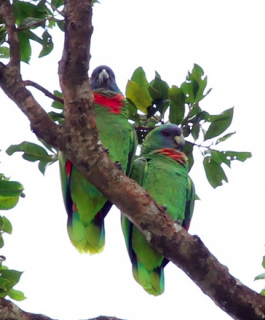Red-necked Amazon |
|
|
Also known as: Red-necked Parrot, Dominican Blue-faced Amazon or Parrot, Lesser Dominican Amazon or Parrot, Bouquet's Amazon or Parrot
Photos
View in GalleryPrograms & Projects
WPT has worked with numerous partners to help save this species. Learn moreAcademic Research
Related publications: Amazona arausiacaSpecies Profile
Genus: Amazona | Species: arausiaca
Size:
40cm (15.6 in)
Weight:
620g (21.7 oz)
Subspecies including nominate:
one
Colour Adult:
Both adults body colour green, the feathers of the nape, neck, and mantle edged with dusty black; purple/blue face; red foreneck; secondary feathers 1-3 red turning into yellow and tipped with purple/blue, secondary feather 4 yellow tinged with green and tipped with purple/blue, the remaining secondary feathers green; green tail with red at base. Bill horn coloured and tipped with grey. Eye ring pale grey. Eye orange.
Colour Juvenile:
In general duller than the adults; red on foreneck minimal or absent. Eye brown.
Call:
Made in flight or when perched are drawn out, two syllable notes; more high-pitched than that of the Imperial Amazon.
Listen NowVideo Links:
Video 1 | Video 2More Information:
Rare Species Conservatory Foundation
Content Sources:
CITES
BirdLife International
Cornell Lab of Ornithology/Birds of the World
A Guide to Parrots of the World, Juniper and Parr, 1998
ML Media Collection Catalogue 93375, Red-necked Parrot Amazona arausiaca, Gulledge, James, Dominica, Dec. 16 1993, Cornell Lab of Ornithology. Site
Parrots: Status Survey and Conservation Plan 2000-2004, Snyder, McGowan, Gilardi and Grajal, 2000.
Parrots of the World, Forshaw, 2006. 2010 edition
Parrots in Aviculture, Low, 1992.
Photos
View in GalleryPrograms & Projects
WPT has worked with numerous partners to help save this species. Learn moreAcademic Research
Related publications: Amazona arausiacaSpecies Care
Captive Status:
Very rare
Longevity:
Not recorded.
Housing:
Walk-in enclosure, minimum length 4.5m (14.7 ft). Metal construction essential.
Diet:
Fruits such as: apple, pear, orange, banana, pomegranates, cactus fruits, forming about 30 percent of the diet; vegetables such as: carrot, celery, green beans and peas in the pod; green leaves such as: Swiss chard, lettuce, sowthistle, dandelion, chickweed; spray millet; small seed mix such as: millet, canary, and smaller amounts of buckwheat, safflower and oats; soaked and sprouted sunflower seed; cooked beans and pulses and boiled maize, and complete pellet.
Enrichment:
Are vigorous chewers so provide heat sterilized pine cones, bird-safe fir, willow, elder or pine branches, vegetable tanned leather chew toys and wood block toys.
Nest Box Size:
Vertical box 14" x 14" x 48" (35.5cm x 35.5cm x 122cm).
Clutch Size:
2-3
Incubation Time:
26-28 days
Fledging Age:
Probably 10-11 weeks
Hatch Weight:
Not recorded.
Peak Weight:
Not recorded.
Weaning Weight:
Not recorded.
Photos
View in GalleryPrograms & Projects
WPT has worked with numerous partners to help save this species. Learn moreAcademic Research
Related publications: Amazona arausiacaSpecies Wild Status
World Population:
1200-1500
IUCN Red List Status:
Vulnerable
CITES Listing:
Appendix I
Threat Summary:
A BirdLife 'restricted-range' species. Affected by habitat loss due to agriculture, mainly banana plantations. Hurricanes have also reduced population numbers, and Illegal trade and hunting are threats.
Range:
Dominica, Lesser Antilles, West Indies.
Habitat:
Found from 300-800m (984-2624 ft) in the canopy of mountain rainforest, preferring Dacryodes excelsa stands. Formerly a regular visitor to coastal areas.
Wild Diet:
Feeds on fruits and seeds of Dacryodes, Licania, Richeria, Amanoa, Simarouba, Symphonia, Cordia, Pithecellobium, Byrsonima, Anacardium, Pouteria, Dussia, Ormosia, palms and sometimes wild guava and cultivated citrus.
Ecology and Behaviour:
Seen in pairs or small groups with larger flocks formed outside of breeding season. Roosts at traditional communal sites used from year to year. Feeds in early morning and evening.
Clutch and Egg Size:
2
Breeding Season:
February-June; nest is in tree cavity.
Related Links:
Photos
View in GalleryPrograms & Projects
WPT has worked with numerous partners to help save this species. Learn moreAcademic Research
Related publications: Amazona arausiacaMembers Only Resources
Please log-in now to find more research, resources and tools.
Not a Member?
Find more great information:
Gain exclusive access to 600+ pages of additional research, seminars and podcasts, specialists to ask your toughest questions, and dozens of other fun resources - when you become a WPT member.
Join Today >>

































